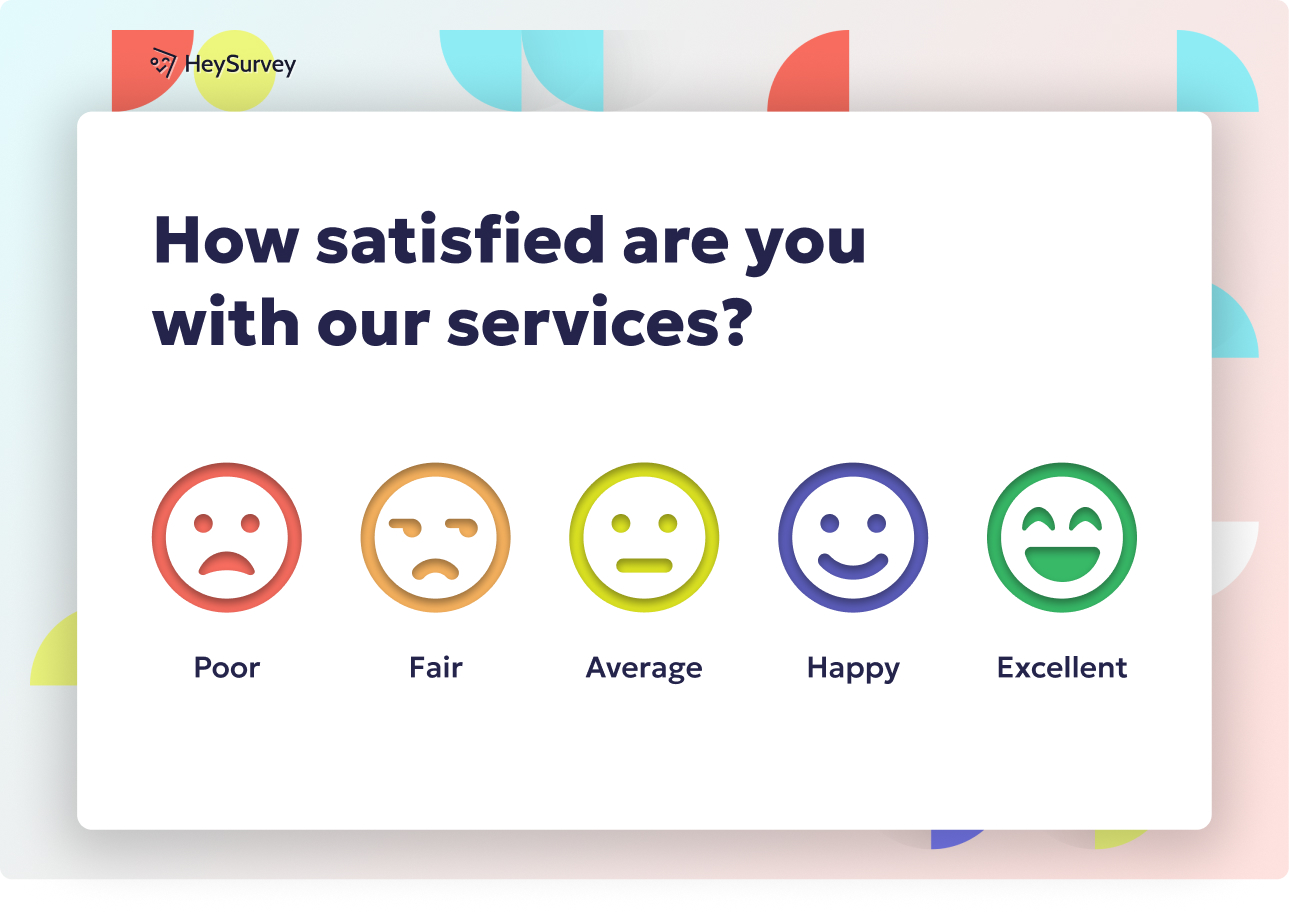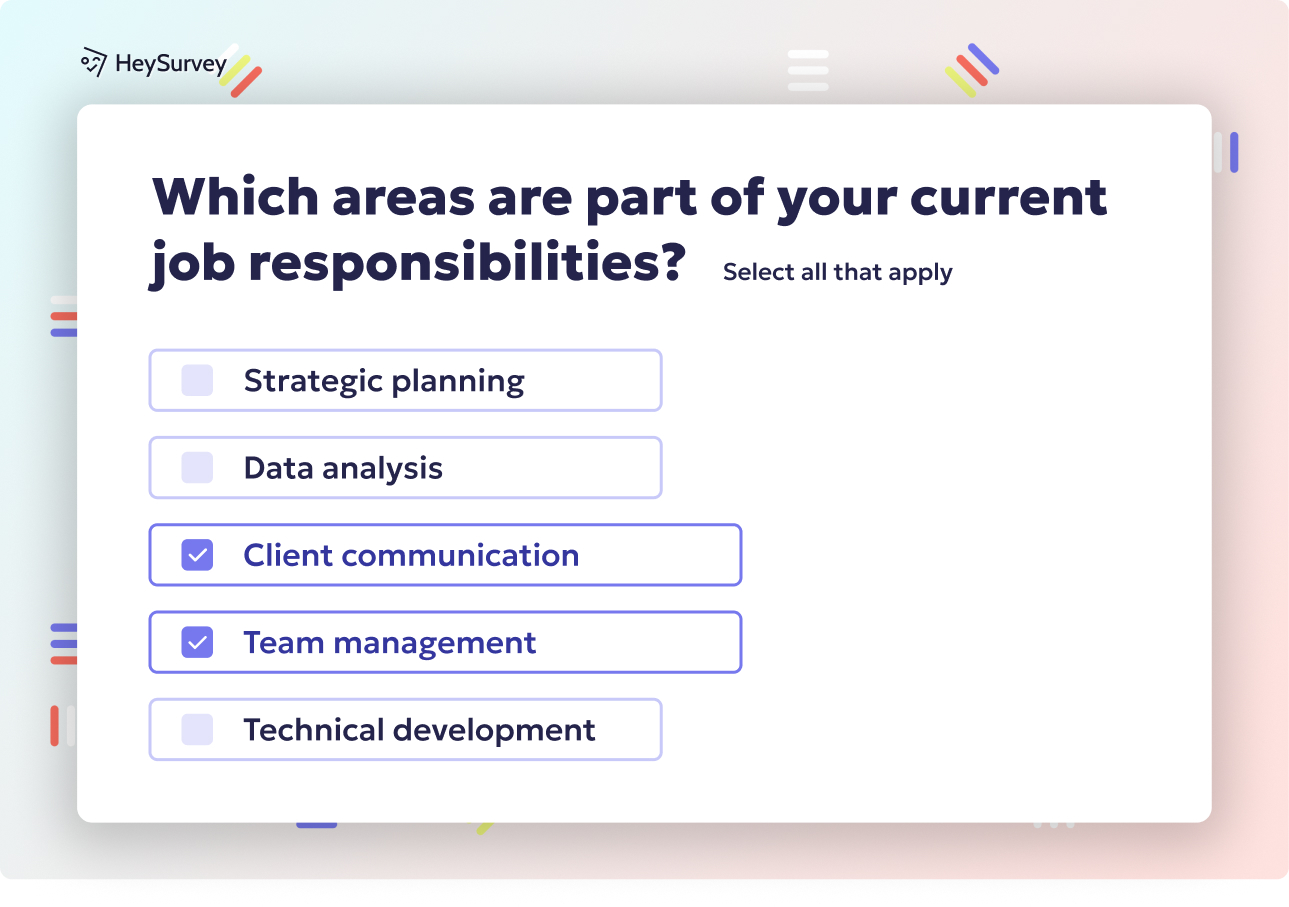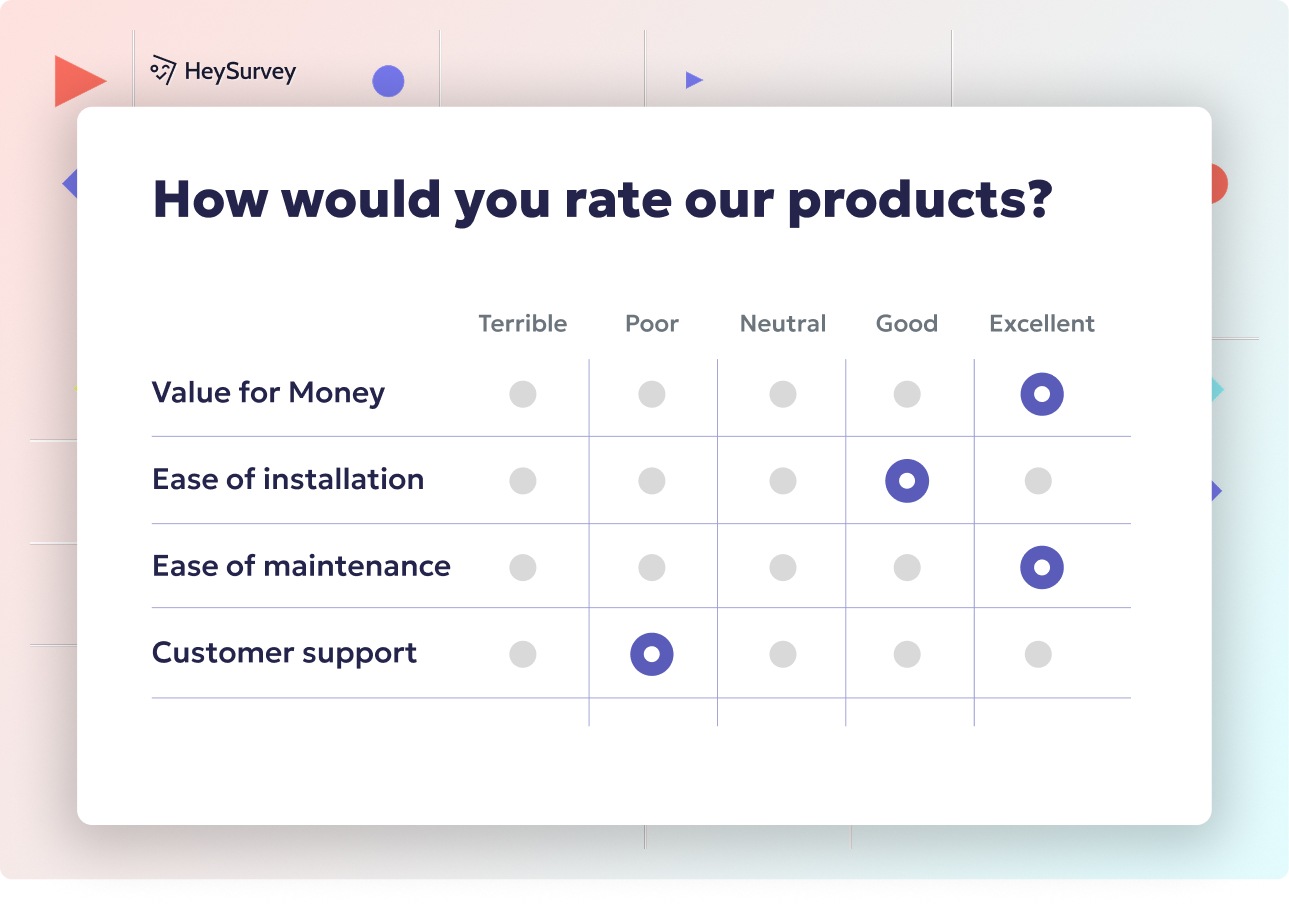40+ Technology Survey Questions: Types, Use-Cases & Best Practices
Explore 40+ technology survey questions with sample templates, use-cases, and best practices to boost product adoption, UX, IT support, and more.
Introduction: Why & When to Use Technology-Focused Surveys
In today's fast-paced digital world, technology survey questions are essential tools for understanding user experiences, identifying adoption barriers, and uncovering opportunities for innovation. By crafting targeted surveys, organizations can gain valuable insights into product usage, user satisfaction, and skill gaps, which are crucial for informed decision-making. This article delves into various types of technology-focused surveys, their specific use-cases, and best practices to enhance response rates and data quality.
Product Usage & Adoption Survey Questions
Why & When to Use
Product usage and adoption surveys are vital for assessing how users interact with a product post-launch. Deploying these surveys 30–90 days after implementation helps identify potential churn risks and areas for product-led growth. They provide insights into onboarding success, feature adoption rates, and overall user engagement.
5 Sample Questions
How often do you use [product/feature] in a typical week?
Which device(s) do you primarily use to access the product?
What, if anything, prevented you from using [feature] more frequently?
On a scale of 1–10, how easy was the initial setup process?
Which alternative tools, if any, have you considered switching to?
These questions are designed to gather actionable insights into user behavior and preferences, aiding in refining product strategies.
Effective product usage surveys incorporate a mix of demographic, usage, satisfaction, feature-specific, and open-ended questions to gather comprehensive user insights. (involve.me)

How to Create Your Technology Survey with HeySurvey — 3 Easy Steps
If you want to quickly get your tech survey off the ground but don’t know where to start, HeySurvey makes it super simple — no steep learning curve, promise! Ready to dive in? Here’s the lowdown, step-by-step, including a couple of bonus tips to add some sparkle.
Step 1. Create a New Survey
Head over to HeySurvey and click Create New Survey. If you want a running start, choose a technology survey template from the library (like the ones tailored for product usage feedback or IT skills assessment). This way, you’ll skip the boring setup part and get straight to the good stuff with pre-built structure and question types aligned to your survey goals.
Step 2. Add Your Survey Questions
Now it’s time to add your questions. Click Add Question and pick the type that fits best — multiple choice, scale (perfect for satisfaction ratings), text input, and more. Pop in your custom questions or tweak the template ones to match your product or internal tool. Don’t forget, HeySurvey lets you make questions required, add images or descriptions, and even create smart branches to skip irrelevant questions based on previous answers.
Step 3. Publish Your Survey
Almost there! Hit the Preview button to double-check how your survey looks across devices, then click Publish. You’ll get a shareable link to send out, embed, or post wherever your audience hangs out. Keep in mind, you’ll need an account to publish and track responses, but signing up is quick and easy.
Bonus Steps to Level Up Your Survey
Apply Branding: Upload your company logo and choose colors and fonts in the Designer Sidebar. This ensures your survey looks professional and on-brand.
Define Settings: Set start/end dates, limit the number of responses, or configure a redirect URL after completion. Handy if you’re running a timed campaign or special feedback round!
Skip into Branches: For a more tailored experience, set up branching logic to lead respondents down different paths based on their answers. This keeps your survey relevant and engaging.
Ready to get hands-on? Just hit the button below to launch a pre-configured tech survey template and start collecting insights like a pro!
User Satisfaction & Experience (UX) Survey Questions
Why & When to Use
User satisfaction and experience surveys are essential for gauging overall contentment, identifying usability pain points, and calculating the Net Promoter Score (NPS). Conducting these surveys after key user interactions or at regular intervals helps in understanding user sentiments and areas needing improvement.
5 Sample Questions
How satisfied are you with the overall performance of [product] today?
Which aspect of the interface feels most intuitive?
Rate the speed of page loads on a scale of 1–7.
How likely are you to recommend [product] to a colleague? (NPS)
Describe one improvement that would enhance your experience.
These questions aim to capture user feedback on performance, usability, and overall satisfaction, guiding UX enhancements.
A study found that user satisfaction surveys are crucial for identifying usability issues and improving Net Promoter Scores (NPS). Source
Feature Prioritization Survey Questions
Why & When to Use
Feature prioritization surveys assist in ranking development tasks based on customer value, especially during beta programs or when resources are limited. They help in making informed decisions about which features to develop next, aligning with user needs and business goals.
5 Sample Questions
Which of the following upcoming features would be most valuable to you? (rank order)
How critical is [feature] to meeting your business goals? (1-5)
Would you pay extra for advanced analytics? (Yes/No)
What current task takes the most time in our platform?
Which integrations should we build next: [options]?
These questions are crafted to prioritize features that deliver the most value to users and the business.
Technology Readiness & Skills Assessment Survey Questions
Why & When to Use
Technology readiness and skills assessment surveys are crucial for identifying employee proficiency and training needs before rolling out new software or enterprise systems. Conducting these surveys pre- and post-training helps in tracking skill development and ensuring effective technology adoption.
5 Sample Questions
How confident are you in using cloud-based collaboration tools?
Which programming languages are you comfortable with? (select all)
Rate your ability to troubleshoot common software issues.
What learning format do you prefer (video, live workshop, self-paced)?
Which certification(s) are you interested in obtaining this year?
These questions aim to assess current skill levels and identify areas for development, facilitating targeted training programs.
Large language models can effectively annotate user-generated content, offering a practical alternative to traditional surveys for analyzing technology acceptance. (arxiv.org)
Emerging Technology Awareness Survey Questions
Why & When to Use
Emerging technology awareness surveys measure familiarity with technologies like AI, IoT, and blockchain, guiding R&D and marketing strategies. Conducting these surveys annually or before launching thought-leadership content helps in understanding market readiness and interest.
5 Sample Questions
How familiar are you with generative AI tools like ChatGPT?
Which emerging tech trends do you believe will impact your industry most?
Have you piloted any Internet of Things (IoT) solutions in the past 12 months?
What concerns do you have about adopting blockchain technology?
How would you rate your organization’s innovation culture?
These questions are designed to gauge awareness and perceptions of emerging technologies, informing strategic decisions.
IT Support & Service Desk Survey Questions
Why & When to Use
IT support and service desk surveys collect feedback on ticket resolution speed, communication quality, and self-service tools. Sending these surveys automatically after ticket closure or during quarterly pulse checks helps in assessing support effectiveness and identifying improvement areas.
5 Sample Questions
How satisfied were you with the response time to your ticket?
Was the solution provided effective on first contact? (Yes/No)
Rate the professionalism of the support agent.
How easy was it to find answers in our knowledge base?
What could the IT team do to improve your support experience?
These questions aim to evaluate the quality of IT support services and gather actionable feedback for enhancements.
Digital Transformation Impact Survey Questions
Why & When to Use
Digital transformation impact surveys evaluate organizational benefits, ROI, and employee sentiment post-digital initiatives. Conducting these surveys 6–12 months after major transformation milestones helps in assessing the success and areas for improvement of digital strategies.
5 Sample Questions
To what extent has the new system improved your daily workflows?
Have you noticed a reduction in manual tasks? (Yes/No)
Rate the overall impact of digital transformation on customer satisfaction.
What unforeseen challenges have arisen during the transition?
How aligned do you feel with the organization’s digital vision?
These questions are designed to measure the effectiveness and impact of digital transformation efforts within the organization.
Best Practices: Dos and Don’ts for Technology Surveys
Do define clear objectives and align questions to KPIs; Don’t overload surveys—keep completion time under 7 minutes.
Do use plain, jargon-free language; Don’t assume technical proficiency across all respondents.
Do segment audiences (admins vs. end-users) for actionable insights; Don’t mix multiple goals in one survey.
Do pilot test for logic and device responsiveness; Don’t forget mobile-first design.
Do close the loop by sharing results and next steps; Don’t let valuable feedback die in spreadsheets.
Implementing these best practices ensures that technology surveys are effective, user-friendly, and yield actionable insights.
In conclusion, well-crafted technology-focused surveys are indispensable for organizations aiming to enhance product offerings, improve user experiences, and drive strategic initiatives. By adhering to the outlined best practices and utilizing the provided sample questions, businesses can gather meaningful feedback that propels growth and innovation.
Related IT Survey Surveys

31 Power BI Survey Questions: Types, Samples & Best Practices
Discover 30+ Power BI survey questions covering adoption, features, training, performance, securi...

29 Post Implementation Survey Questions to Boost Success
Explore essential post implementation survey questions with 30 sample questions to boost user sat...

31 IT Department Survey Questions for Employees to Boost Feedback
Discover 35 essential IT department survey questions for employees to gather actionable feedback ...